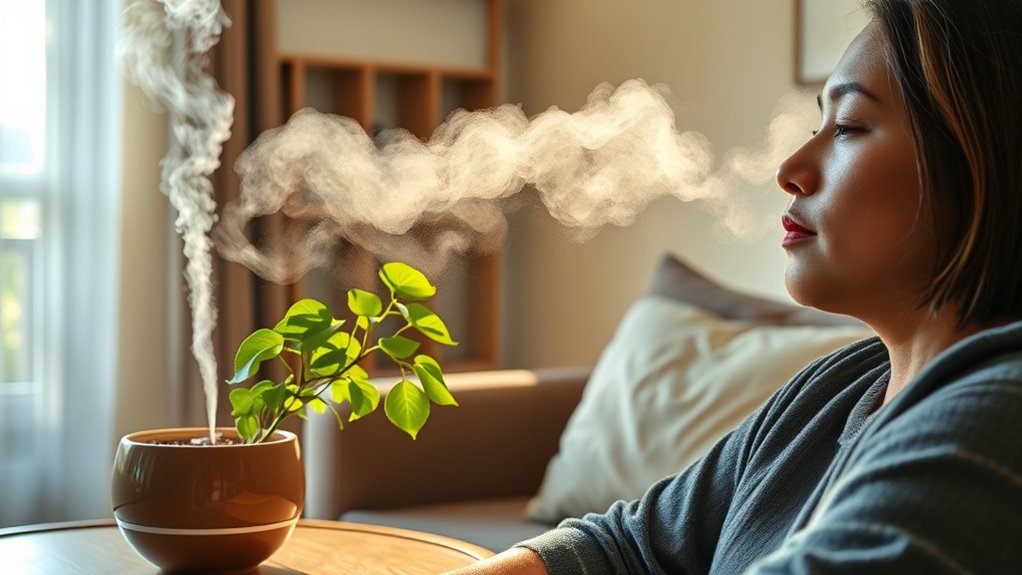Humidity directly affects how comfortably you breathe and how odors linger in the air. Low humidity can dry out your nasal passages, causing irritation and making it easier for dust and allergens to irritate your respiratory system. High humidity, on the other hand, makes air feel heavy, worsens allergies, and traps scents, intensifying odors. Managing humidity levels helps you breathe better and keeps indoor smells under control—if you want to know how, keep exploring this topic.
Key Takeaways
- Proper humidity supports lung function by preventing mucous membranes from drying out, reducing coughing and irritation.
- Low humidity disperses odors quickly, causing them to fade faster, while high humidity traps scent molecules, intensifying odors.
- Excess moisture from high humidity promotes mold and dust mites, worsening allergies and asthma symptoms.
- Dry air from low humidity impairs mucus production, decreasing the body’s ability to trap pollutants and pathogens.
- Maintaining balanced indoor humidity (40-60%) helps improve breathing comfort and controls unpleasant odors effectively.
The Impact of Humidity on Respiratory Comfort

Humidity levels directly affect your respiratory comfort by influencing the moisture content in the air you breathe. When the air is too dry, your nasal passages and throat can become irritated, leading to discomfort and increased susceptibility to infections. Low humidity can cause your mucous membranes to dry out, making it harder to trap dust, allergens, and bacteria. Conversely, high humidity makes the air feel heavy and can cause breathing to feel labored, especially if you have respiratory conditions like asthma. Excess moisture can also promote mold growth, which can further irritate your respiratory system. Maintaining balanced humidity helps keep your airways moist and comfortable, reducing irritation and supporting easier breathing throughout the day. Using an air purifier with HEPA filtration can help remove airborne allergens and improve indoor air quality, especially in environments with fluctuating humidity levels.
How Moisture Levels Influence Lung Function

When moisture levels in the air are balanced, your lungs can function more efficiently by maintaining proper airway hydration. Adequate humidity prevents your respiratory passages from becoming dry and irritated, reducing coughing and discomfort. When air is too dry, the mucous membranes in your lungs dry out, impairing mucus production necessary for trapping dust, pathogens, and pollutants. This makes it harder to clear these particles, increasing your risk of infections and inflammation. Conversely, overly humid air can cause excess mucus production, leading to congestion and breathing difficulty. Maintaining ideal moisture levels helps keep your lung tissues supple and functioning smoothly, supporting better airflow and oxygen exchange. Proper humidity levels directly influence your lung’s ability to perform its essential role in respiration effectively. Additionally, air quality management can help mitigate the negative impacts of humidity fluctuations on respiratory health.
The Relationship Between Humidity and Odor Intensity

Balancing moisture levels in the air not only affects lung health but also influences how we perceive odors around us. When humidity is high, odors tend to become more intense and lingering because moisture traps scent molecules, making them harder to dissipate. Conversely, low humidity can cause odors to fade quickly as scent molecules disperse faster in dry air. To visualize this, consider the following:
| Humidity Level | Odor Intensity | Scent Duration |
|---|---|---|
| High | Strong | Lasts longer |
| Moderate | Noticeable | Moderate duration |
| Low | Faint | Fades quickly |
| Very Low | Almost undetectable | Very brief |
Understanding this helps you manage indoor air quality and odor control effectively.
Effects of High and Low Humidity on Respiratory Conditions

High levels of humidity can exacerbate respiratory conditions by creating an environment that promotes mold growth, dust mites, and other allergens. If your air feels damp, you’re more likely to experience increased asthma symptoms, coughing, and congestion. Excess moisture can also make breathing feel heavier, especially during physical activity. Conversely, low humidity dries out your nasal passages and throat, making them more vulnerable to irritation and infections. You might notice increased sneezing, sore throat, or breathing discomfort. Both extremes can worsen existing respiratory issues, making it harder to breathe comfortably. Maintaining balanced humidity levels helps reduce allergen buildup and keeps your airways healthier. Paying attention to indoor humidity can *considerably* improve your respiratory health and overall comfort. Additionally, AI safety measures are being developed to monitor and mitigate vulnerabilities in health-related technology, ensuring safer environments.
Tips for Managing Indoor Humidity for Better Breathing and Smell Perception

To effectively manage indoor humidity for better breathing and smell perception, start by monitoring the humidity levels with a reliable hygrometer. Aim to keep humidity between 40% and 60%, which helps prevent mold growth and reduces airborne allergens. Use a dehumidifier in damp areas to lower excess moisture or a humidifier if the air is too dry. Ventilate regularly by opening windows or using exhaust fans to improve airflow and freshen the air. Keep your home clean to reduce dust and mold, which can affect smells and respiratory health. Additionally, fix leaks promptly and avoid overwatering plants indoors. Maintaining balanced humidity is essential for indoor air quality and will help reduce pollutants that can cause odors and respiratory issues. By doing so, you’ll breathe easier, and odors will dissipate more quickly, creating a healthier living environment.
Frequently Asked Questions
Can Humidity Levels Affect Sleep Quality and Respiratory Rest?
Yes, humidity levels can impact your sleep quality and respiratory rest. When the air is too dry, your throat and nasal passages may become irritated, making it harder to breathe comfortably and disrupting sleep. Conversely, high humidity can cause congestion and promote mold growth, which can worsen respiratory issues. Maintaining a balanced humidity level, around 40-60%, helps you breathe easier and enjoy restful sleep.
How Does Humidity Influence the Spread of Airborne Respiratory Viruses?
You might think higher humidity just makes things damp, but it also impacts virus spread. Research shows that in humid environments, respiratory viruses like influenza struggle to stay airborne, reducing infection chances. Conversely, low humidity allows viruses to linger longer on surfaces and in the air, increasing your risk. So, maintaining ideal humidity levels can help control the spread of airborne viruses and protect your health.
Are There Long-Term Health Effects From Chronic Exposure to High Humidity?
Chronic exposure to high humidity can lead to long-term health issues you might not notice right away. It can cause mold growth, which triggers allergies and respiratory problems over time. You might also experience skin irritations or infections due to damp conditions. Additionally, high humidity can weaken your immune system, making you more vulnerable to illnesses. To protect your health, control indoor humidity levels and keep your environment dry and well-ventilated.
How Does Humidity Impact the Effectiveness of Respiratory Medications?
Humidity levels can substantially influence how well your respiratory medications work. When the air is too dry, your airways may become irritated, reducing medication effectiveness. Conversely, high humidity can cause mucus buildup, making it harder for inhalers to reach your lungs properly. You should monitor indoor humidity, ideally keeping it between 30-50%, to guarantee your medications work at their best and your breathing stays comfortable.
Can Adjusting Indoor Humidity Improve Symptoms of Allergies or Asthma?
You can definitely improve allergy or asthma symptoms by adjusting indoor humidity. Keeping it around 40-50% helps prevent mold, dust mites, and other allergens from thriving, reducing irritation. If it’s too dry, you might experience dry throat and increased airway irritation, while too humid can promote mold growth. Use a humidifier or dehumidifier to find the right balance, making breathing easier and minimizing odors caused by excess moisture.
Conclusion
Understanding how humidity affects your breathing and sense of smell can really improve your comfort. Did you know that indoor humidity levels above 60% can increase mold growth, worsening respiratory issues? By maintaining ideal humidity between 40-60%, you can breathe easier and enjoy fresher odors. Managing moisture isn’t just about comfort — it’s about protecting your health. Keep an eye on humidity levels, and you’ll notice a significant difference in how you breathe and perceive smells daily.









